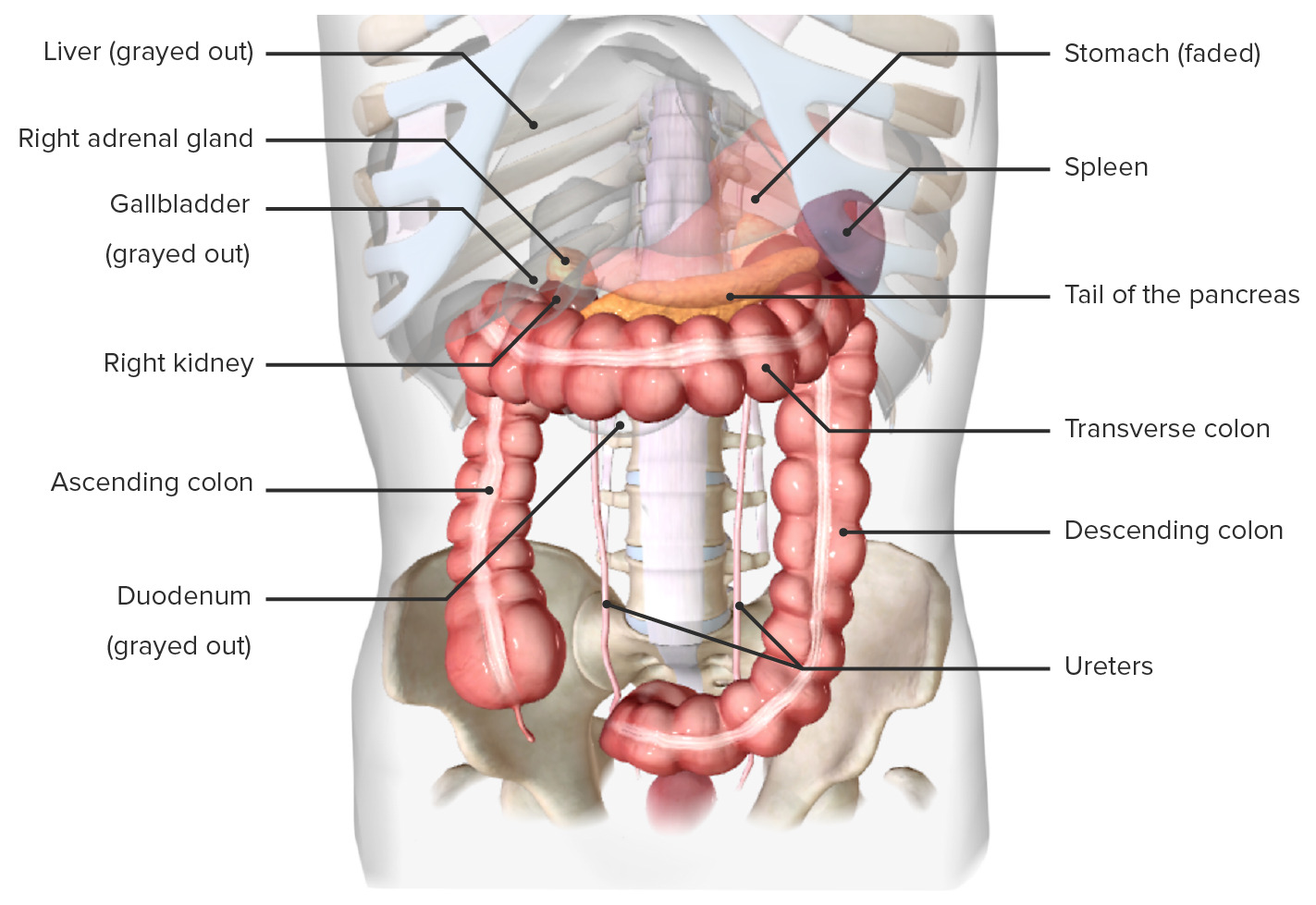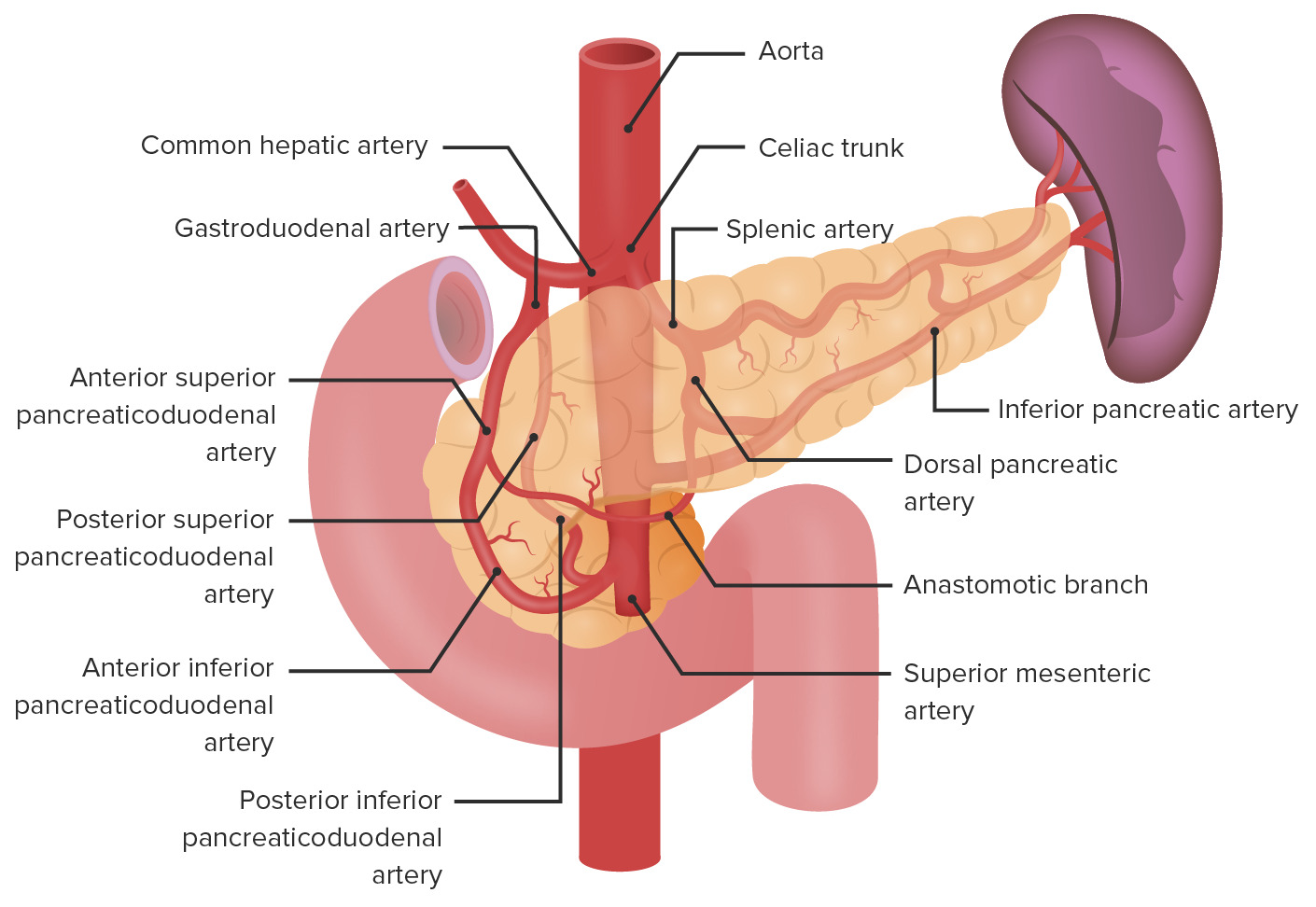Playlist
Show Playlist
Hide Playlist
Anatomy of the Spleen
-
Slides Anatomy of the Spleen.pdf
-
Download Lecture Overview
00:01 Now, let's turn our attention to the spleen. 00:04 The spleen is quite a small organ although it can be variable in size. 00:08 But it's really quite an important organ that situated against the ribs down in the left hand aspect of the abdomen. 00:16 It's really pushed up against the ribs, and it sits between ribs 10, 11, and 12. 00:21 And it's actually really closely associated with them. 00:25 So a fracture to those ribs can quite easily puncture the spleen. 00:30 If we were to have a look at the Spleen: In Situ, then we can see it's quite difficult to see here. 00:35 But it's up in that left upper quadrant. 00:38 And it's clearly hidden. 00:40 You can just make out the inferior part of it by the stomach. 00:43 So we can see the spleen there, and we can see that stomach sits anterior to it. 00:49 If we were to remove the stomach, when we had a look at the pancreas, we can now appreciate the tail of the pancreas is passing very much into the hilum of the spleen. 00:59 And we can see it here in a slightly different position. 01:02 So, here we can see the tail of the pancreas passing up into the spleen. 01:07 And this is that viseral surface of the spleen, which has an association with the stomach and various other organs like you can see parts of the kidney here. 01:17 And we have a diaphragmatic surface which we can see here. 01:20 And that is positioned against the diaphragm, which is closely tucked up against those ribs 10, 11, and 12. 01:27 If we continue to look at the spleen, we see it has an inferior pole here, which is protecting downwards into the abdomen, and also the superior pole, which will also be tightly situated next to the diaphragm. 01:40 So here we can see that resource surface, and the superior and inferior pole. 01:45 We are looking at the hilum of the spleen here, as if we were standing where the stomach is, and looking left. 01:52 We can see the splenic artery and vein which be passing posterior to the stomach, posterior to the pancreas, and heading to the left towards the spleen. 02:02 So here we are looking at that visceral surface. 02:06 We can see we have an Anterosuperior border which is projecting upwards and forwards, and a posteroinferior border projecting posteriorly and backwards. 02:16 Here we have the the hilum of the spleen, which is receiving those blood vessels. 02:20 Here we have the splenic artery, and we have the splenic vein. 02:25 We also have a number of splenic impressions which are located on this visceral surface. 02:30 Here we have the gastric impression where we have the body of the stomach sitting against this visceral surface of the spleen. 02:37 We also have the renal impression, where the superior pole of the left kidney is located. 02:42 And we have the colic impression, where we have the splenic flexure of the large intestine. 02:47 Remember, that's where the transverse colon then descends as the descending colon in the left upper quadrant of the abdomen. 02:54 So here, we have the colic impression. 02:57 Here we have the diaphragmatic surface. 02:59 So we've spun the spleen around. 03:02 And we can see that very large, broad diaphragmatic surface. 03:06 It is very smooth and a clear surface. 03:09 And we have both the superior and the inferior poles. 03:12 Again, we have the anterosuperior border, and we have the posteroinferior border as well indicated here. 03:20 In some spleens, you may very much on that anterosuperior view. 03:24 See some indentations, and that's very much characteristic of the spleen. 03:29 So here, we can see the spleen again In Situ. 03:32 We can see it has a very intimate association with the peritoneum. 03:36 We can see that it is therefore an intraperitoneal organ. 03:40 And because it's an intraperitoneal organ, it's going to be suspended by various other peritoneal ligaments. 03:47 So here we have the phrenosplenic ligament that's going from the diaphragm to the spleen. 03:53 We have the splenocolic ligament, which is going from the spleen to the transverse colon, very much around the splenic flexure where the transverse colon becomes the descending colon. 04:03 And here we have the spleorenal ligament, which is what's taking that peritoneum from the posterior abdominal wall at the level of the kidney. 04:11 It's picking up the tail of the pancreas and running towards the hilum of the spleen. 04:16 This is an important ligament as it allows both the splenic artery and vein to enter into the hilum of the spleen. 04:24 Finally, where the stomach is situated against the spleen, we have the gastrosplenic ligament. 04:30 So you can see the spleen is suspended by a large number of peritoneal ligaments.
About the Lecture
The lecture Anatomy of the Spleen by James Pickering, PhD is from the course Anatomy of the Pancreas and Spleen.
Included Quiz Questions
Which boundary of the omental bursa does the spleen form?
- Left
- Superior
- Inferior
- Right
- Posterior
Which ribs, when fractured, could rupture the spleen?
- Left 9th, 10th, and 11th
- Right 10th, 11th, and 12th
- Left 6th, 7th, and 8th
- Left 5th, 6th, and 7th
- Left 11th and 12th
Which organ forms an inferior impression on the spleen?
- Left kidney
- Stomach
- Splenic flexure of the colon
- Pancreas
- Transverse colon
Customer reviews
5,0 of 5 stars
| 5 Stars |
|
5 |
| 4 Stars |
|
0 |
| 3 Stars |
|
0 |
| 2 Stars |
|
0 |
| 1 Star |
|
0 |





